
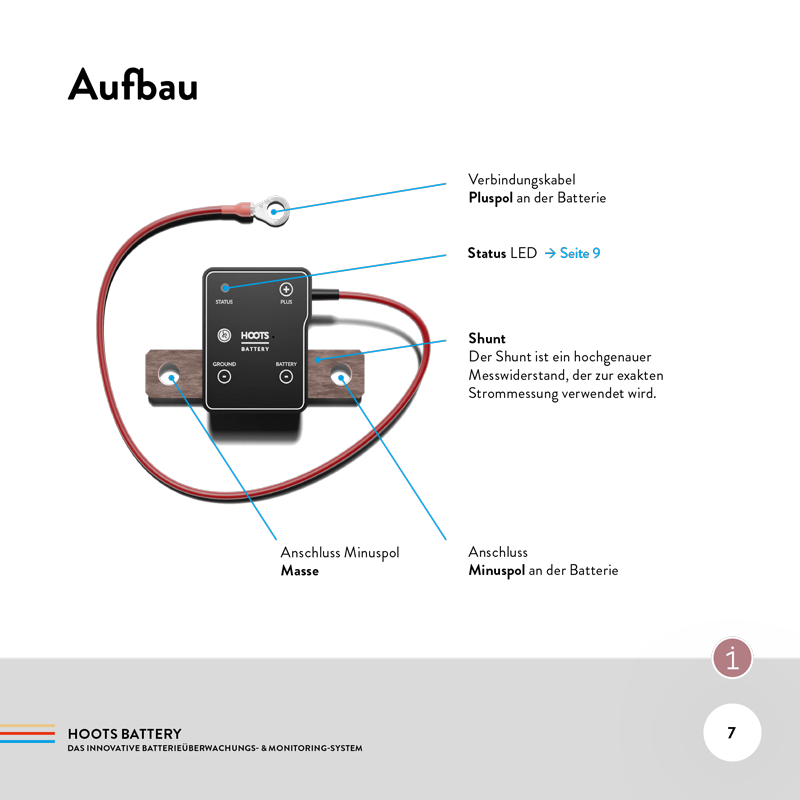
Was ist ein Batteriemanagement-system?
Ein Batteriemanagementsystem (BMS) ist eine entscheidende Komponente für die Verwaltung und Überwachung von Batteriepacks, insbesondere bei Lithium-Ionen-Batterien und Lithium-Akkus. Das Battery Management System überwacht den Ladezustand, die Temperatur und die Leistung der einzelnen Zellen innerhalb eines Akkumulators. Es gewährleistet die Sicherheit und Effizienz des Ladevorgangs sowie des Entladens, was besonders wichtig für E-Autos und Elektroautos ist.
Ein BMS ist in der Lage, die Leistung der Batterie zu optimieren, indem es sicherstellt, dass die Batteriezellen innerhalb sicherer Betriebsgrenzen arbeiten. Es verhindert Überladung und Tiefentladung, wodurch die Lebensdauer der Batterie verlängert wird. Die Überwachung und Verwaltung der Batterietemperatur ist ebenfalls ein kritischer Aspekt, da extreme Temperaturen die Effizienz und Sicherheit der Batterien beeinträchtigen können.
In PV-Modulen und anderen Anwendungen, die auf Lithium-Ionen-Batterien angewiesen sind, spielen Batteriemanagementsysteme eine zentrale Rolle. Sie ermöglichen eine effiziente und sichere Nutzung der gespeicherten Energie. Moderne BMS sind das Ergebnis kontinuierlicher Weiterentwicklungen und technologischer Fortschritte im Bereich der Batteriemanagementsysteme.
Ein effektives BMS besteht aus mehreren Komponenten, darunter Sensoren zur Überwachung der Temperatur, Spannung und des Ladezustands der Batteriezellen. Es bietet zudem Schutzmechanismen gegen Überlastung, Überhitzung und Kurzschluss. Durch die Überwachung jeder Einzel-Zelle im Batteriepacksystem wird eine gleichmäßige Verteilung der Last und eine optimale Nutzung der Batterie gewährleistet.
Insgesamt tragen Batteriemanagementsysteme entscheidend zur Leistungsfähigkeit und Sicherheit von Lithium-Ionen-Batterien und Lithium-Akkus bei, indem sie eine präzise Überwachung und Verwaltung ermöglichen.
Was ist ein Batteriemanagement-system?
Ein Batteriemanagementsystem (BMS) ist eine entscheidende Komponente für die Verwaltung und Überwachung von Batteriepacks, insbesondere bei Lithium-Ionen-Batterien und Lithium-Akkus. Das Battery Management System überwacht den Ladezustand, die Temperatur und die Leistung der einzelnen Zellen innerhalb eines Akkumulators. Es gewährleistet die Sicherheit und Effizienz des Ladevorgangs sowie des Entladens, was besonders wichtig für E-Autos und Elektroautos ist.
Ein BMS ist in der Lage, die Leistung der Batterie zu optimieren, indem es sicherstellt, dass die Batteriezellen innerhalb sicherer Betriebsgrenzen arbeiten. Es verhindert Überladung und Tiefentladung, wodurch die Lebensdauer der Batterie verlängert wird. Die Überwachung und Verwaltung der Batterietemperatur ist ebenfalls ein kritischer Aspekt, da extreme Temperaturen die Effizienz und Sicherheit der Batterien beeinträchtigen können.
In PV-Modulen und anderen Anwendungen, die auf Lithium-Ionen-Batterien angewiesen sind, spielen Batteriemanagementsysteme eine zentrale Rolle. Sie ermöglichen eine effiziente und sichere Nutzung der gespeicherten Energie. Moderne BMS sind das Ergebnis kontinuierlicher Weiterentwicklungen und technologischer Fortschritte im Bereich der Batteriemanagementsysteme.
Ein effektives BMS besteht aus mehreren Komponenten, darunter Sensoren zur Überwachung der Temperatur, Spannung und des Ladezustands der Batteriezellen. Es bietet zudem Schutzmechanismen gegen Überlastung, Überhitzung und Kurzschluss. Durch die Überwachung jeder Einzel-Zelle im Batteriepacksystem wird eine gleichmäßige Verteilung der Last und eine optimale Nutzung der Batterie gewährleistet.
Insgesamt tragen Batteriemanagementsysteme entscheidend zur Leistungsfähigkeit und Sicherheit von Lithium-Ionen-Batterien und Lithium-Akkus bei, indem sie eine präzise Überwachung und Verwaltung ermöglichen.

Batteriecomputer per WLAN & Bluetooth
Weltweite Datenübertragung kostenlos per WLAN - keine fortlaufenden Mobilfunkkosten
Energie- & Akkuüberwachung
Stromverbrauch (Ampere) und Batteriespannung (Volt) aller Bootsbatterien jederzeit und überall überwachen
Batteriestatus global prüfen
Abruf der Batteriewerte von Ihrem Boot weltweit per App
Umgebungsmonitoring
Erfassung von Umgebungsparametern wie Temperatur, Luftfeuchte und WLAN-Status
.
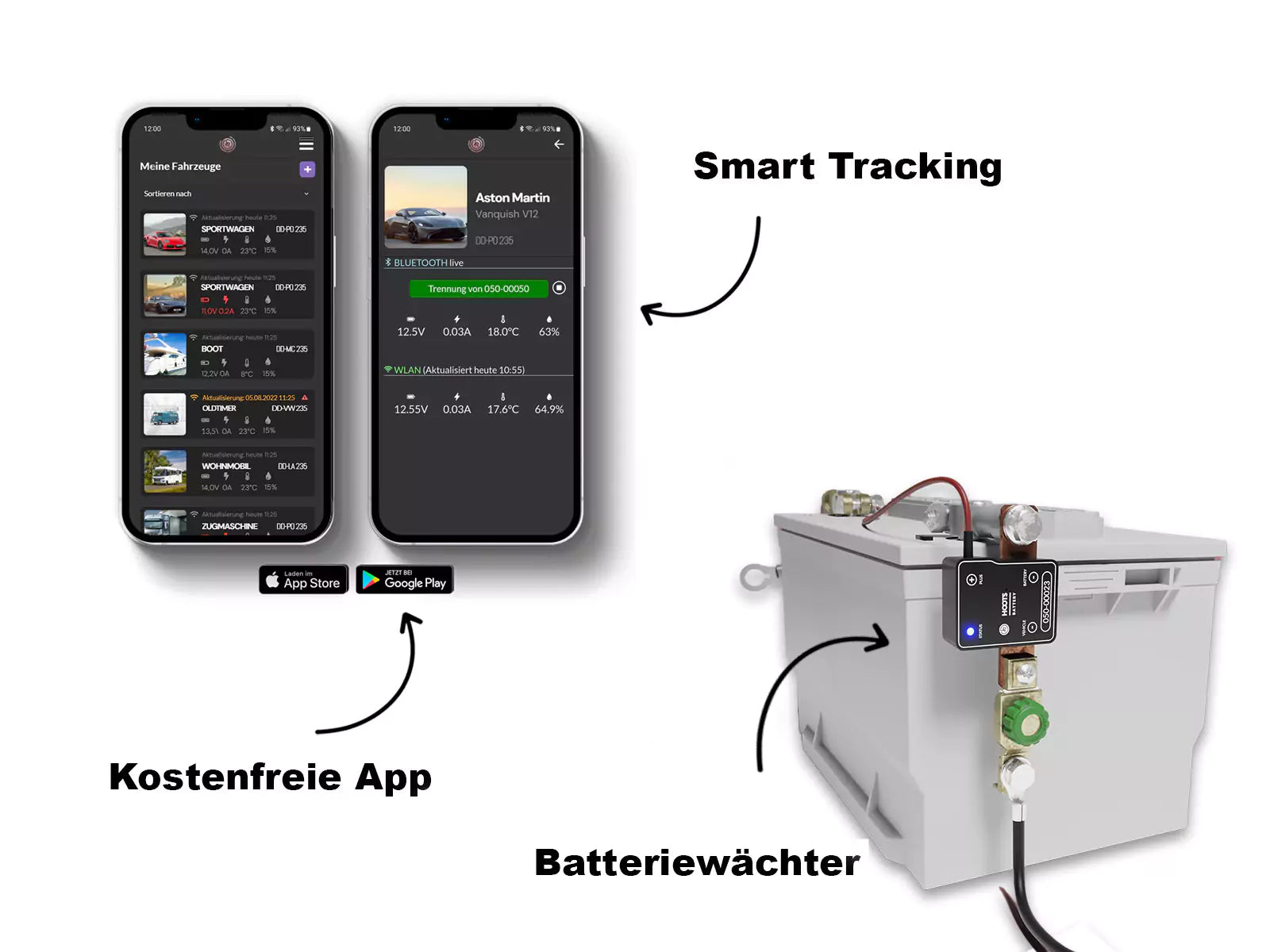

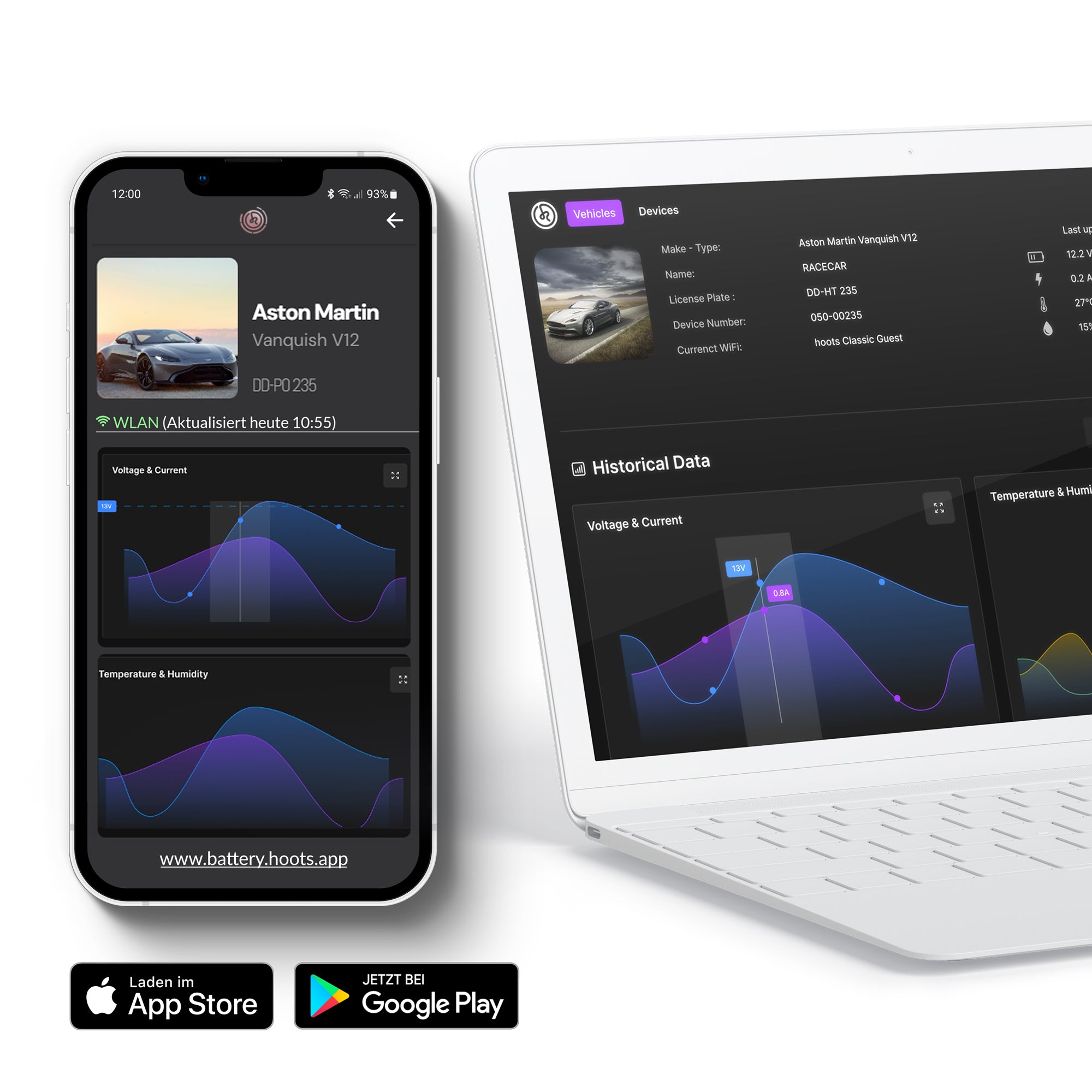

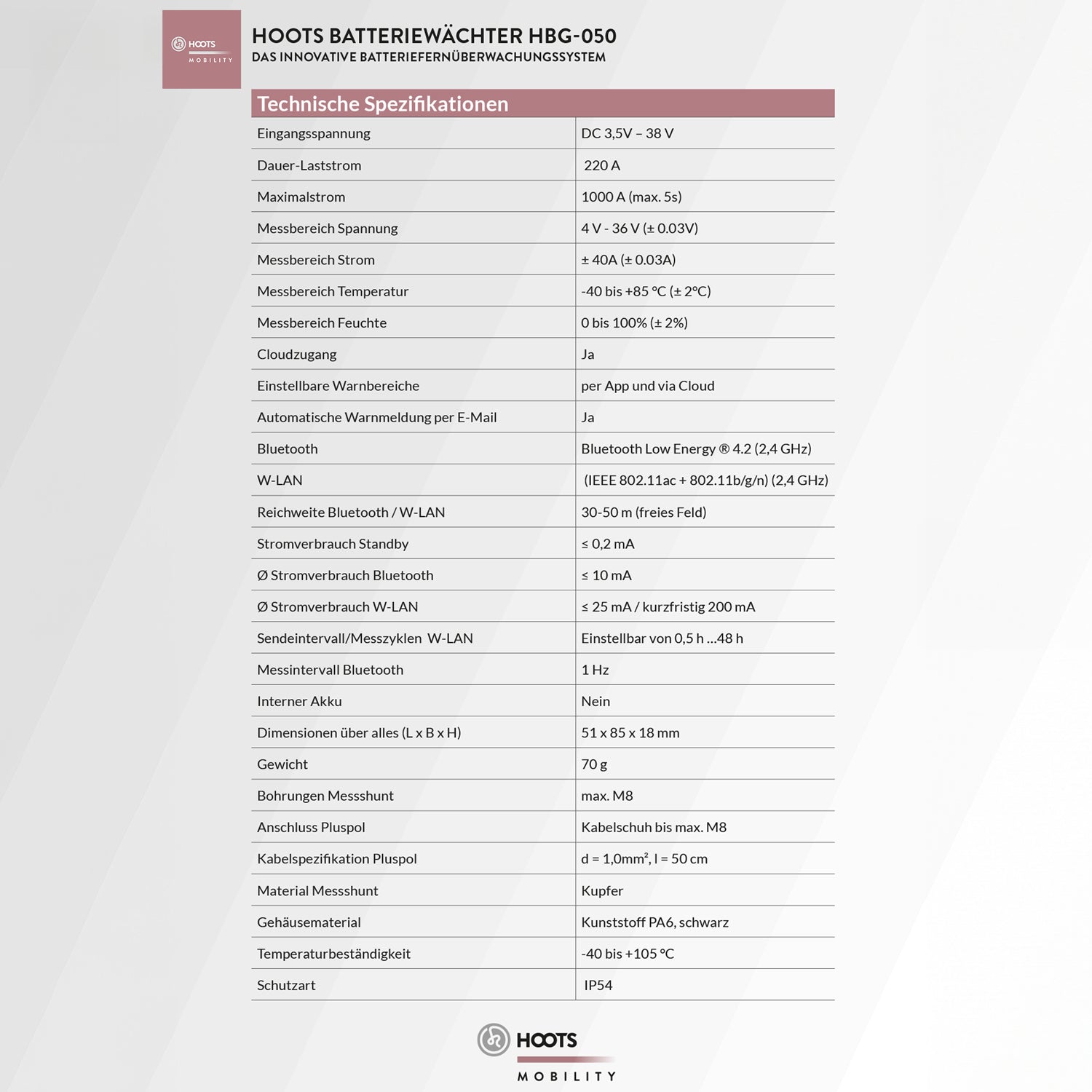
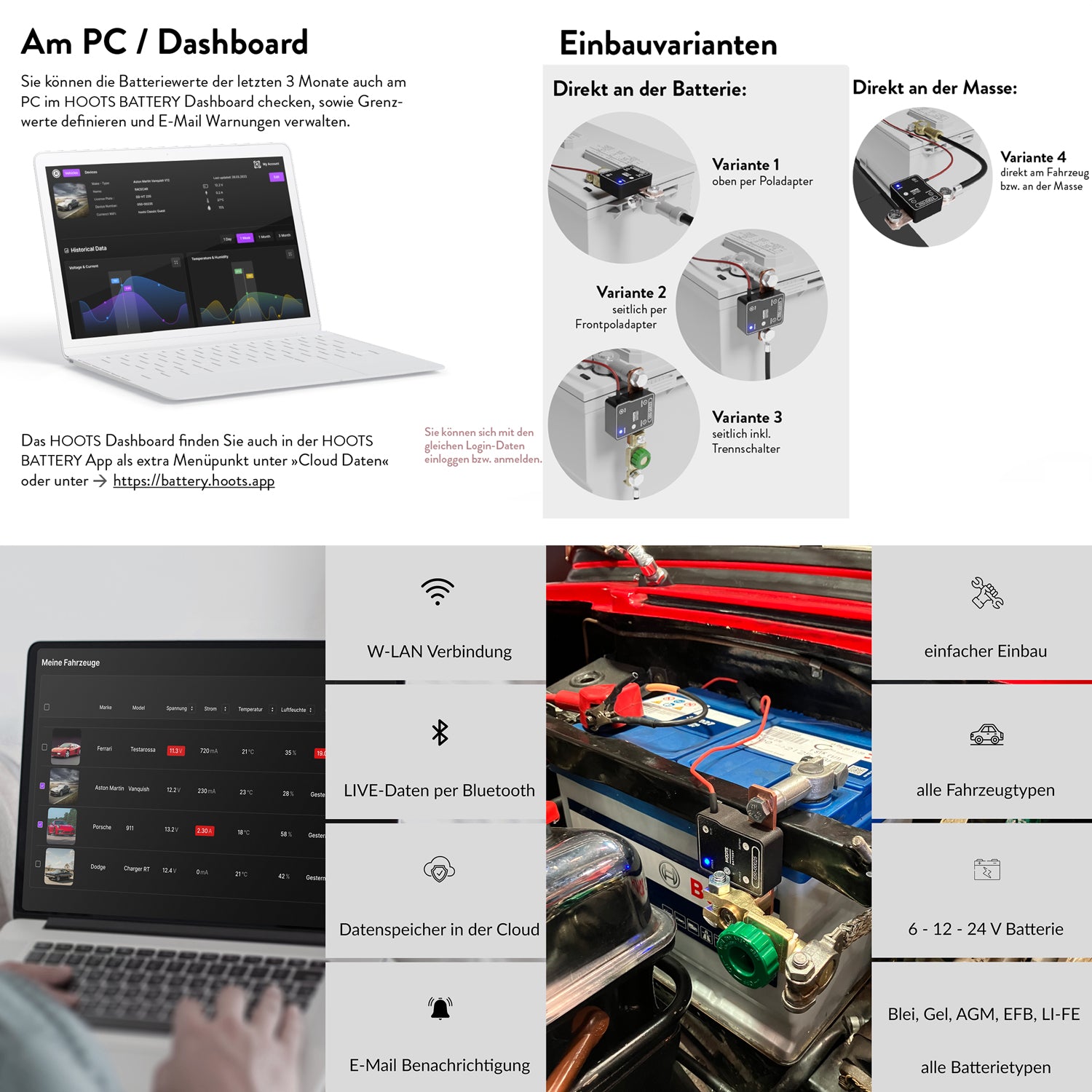
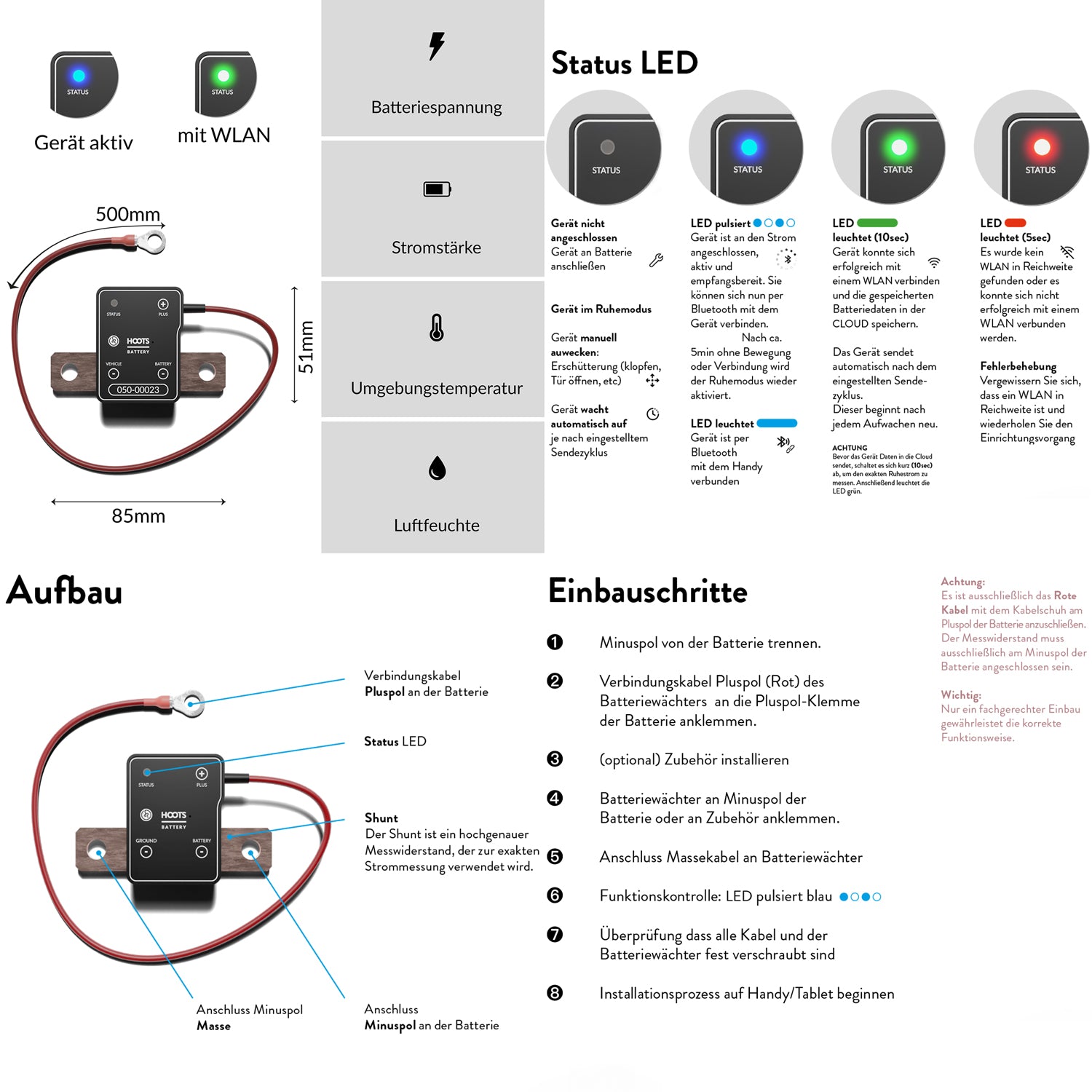
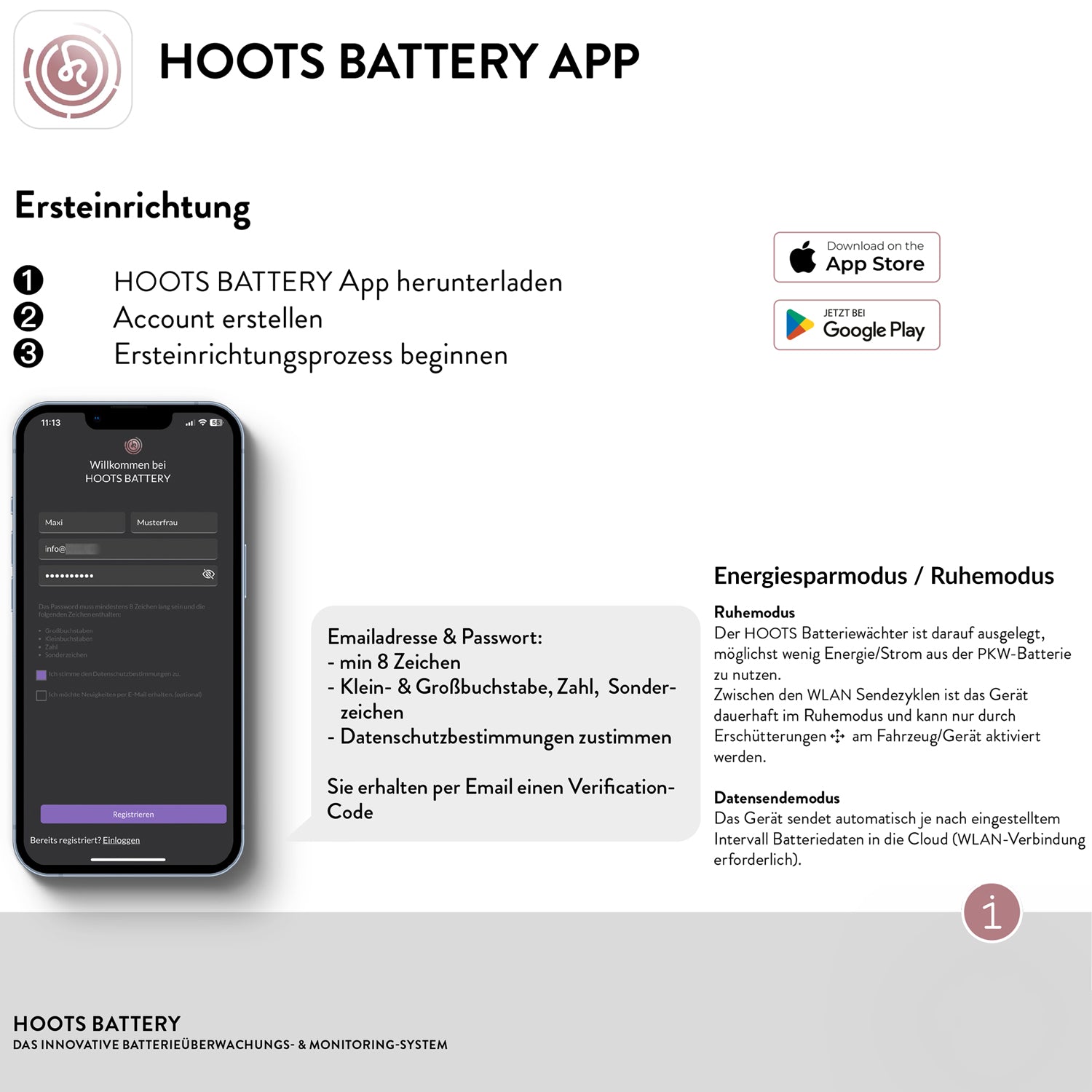
Der HOOTS BATTERY Batteriewächter für effektive & einfache Überwachung deiner Batterie. Erhöhe die Lebensdauer deiner Batterie durch intelligente Kontrollsysteme von Hoots.
✓ Batterieüberwachung für 12V, 24V, 36V Batterien
✓ Kostenfreie App zur Fernüberwachung
✓ Messung: Ampere, Volt, Temperatur & Luftfeuchtigkeit
✓ Komplettsystem inkl. aller Komponenten
✓ Automatisierte Warnmeldung per E-Mail

Wo kann ein Batteriemanagement-system im privaten Bereich und der Industrie eingesetzt werden?
Ein Batteriemanagementsystem 48V und 12V spielt sowohl im privaten Bereich als auch in der Industrie eine wichtige Rolle. In Elektrofahrzeugen und anderen Fahrzeugen optimiert das BMS die Leistungsfähigkeit der Lithium-Ionen-Akkus und überwacht wichtige Parameter wie Ladezustände, Temperaturüberwachung und Ladeausgleich. Es schützt vor Überladung, Überhitzung und Schäden, was die Sicherheit erhöht und die Lebensdauer der Batterie verlängert.
Im privaten Bereich wird ein BMS in Elektromobilität, wie E-Bikes und Solarspeicher, eingesetzt. Es sorgt für effiziente Stromversorgung und optimiert die Reichweite von Elektrofahrzeugen. Durch die Überwachung jeder Einzel-Zelle und die Anpassung der Schaltung gewährleistet es eine gleichmäßige Belastung und verhindert Alterung durch ungleichmäßige Nutzung.
In der Industrie findet das BMS Anwendung in großen Batteriesystemen für die Energieversorgung von Maschinen und Anlagen. Es überwacht Ladezustände, passt die Betriebsparameter an und stellt sicher, dass die Batterien optimal arbeiten. Schnittstellen und Komponenten sind so ausgelegt, dass sie in verschiedene Netzwerke integriert werden können, was die Flexibilität erhöht. Ein BMS Akku überwacht den Ladezustand und die Funktionen des Systems.
Ein Batteriesystem kann auch als BMS Batterie für spezifische Verwendung wie Battery-Management-System 12V bzw. 48V, und BMS Auto verwendet werden. Es ist eine Lösung für Kunden, die sowohl im privaten als auch im industriellen Bereich zuverlässige Batterieüberwachung und -steuerung benötigen. Die Informationen, die durch ein BMS Battery bereitgestellt werden, helfen bei der Verbesserung der Sicherheit und Leistungsfähigkeit der Batterien.
BMS Hersteller bieten eine Vielzahl von Modellen und Produkten an, die auf die spezifischen Bedürfnisse der Kunden zugeschnitten sind. Diese Artikel sind essenziell für die weitere Entwicklung der Elektromobilität und anderer technischer Nutzung. Die Battery Management System Funktion ist entscheidend für den sicheren Betrieb und die Überwachung der Batterie.
Wo kann ein Batteriemanagement-system im privaten Bereich und der Industrie eingesetzt werden?
Ein Batteriemanagementsystem 48V und 12V spielt sowohl im privaten Bereich als auch in der Industrie eine wichtige Rolle. In Elektrofahrzeugen und anderen Fahrzeugen optimiert das BMS die Leistungsfähigkeit der Lithium-Ionen-Akkus und überwacht wichtige Parameter wie Ladezustände, Temperaturüberwachung und Ladeausgleich. Es schützt vor Überladung, Überhitzung und Schäden, was die Sicherheit erhöht und die Lebensdauer der Batterie verlängert.
Im privaten Bereich wird ein BMS in Elektromobilität, wie E-Bikes und Solarspeicher, eingesetzt. Es sorgt für effiziente Stromversorgung und optimiert die Reichweite von Elektrofahrzeugen. Durch die Überwachung jeder Einzel-Zelle und die Anpassung der Schaltung gewährleistet es eine gleichmäßige Belastung und verhindert Alterung durch ungleichmäßige Nutzung.
In der Industrie findet das BMS Anwendung in großen Batteriesystemen für die Energieversorgung von Maschinen und Anlagen. Es überwacht Ladezustände, passt die Betriebsparameter an und stellt sicher, dass die Batterien optimal arbeiten. Schnittstellen und Komponenten sind so ausgelegt, dass sie in verschiedene Netzwerke integriert werden können, was die Flexibilität erhöht. Ein BMS Akku überwacht den Ladezustand und die Funktionen des Systems.
Ein Batteriesystem kann auch als BMS Batterie für spezifische Verwendung wie Battery-Management-System 12V bzw. 48V, und BMS Auto verwendet werden. Es ist eine Lösung für Kunden, die sowohl im privaten als auch im industriellen Bereich zuverlässige Batterieüberwachung und -steuerung benötigen. Die Informationen, die durch ein BMS Battery bereitgestellt werden, helfen bei der Verbesserung der Sicherheit und Leistungsfähigkeit der Batterien.
BMS Hersteller bieten eine Vielzahl von Modellen und Produkten an, die auf die spezifischen Bedürfnisse der Kunden zugeschnitten sind. Diese Artikel sind essenziell für die weitere Entwicklung der Elektromobilität und anderer technischer Nutzung. Die Battery Management System Funktion ist entscheidend für den sicheren Betrieb und die Überwachung der Batterie.

Welche Rolle spielt ein Batteriemanagementsystem für Automobile und Fahrzeuge?
Ein Batteriemanagementsystem (BMS) Funktion spielt eine entscheidende Rolle für Automobile und Fahrzeuge, indem es die Batterieüberwachung und Batteriemanagement optimiert. Es fungiert als Batteriewächter, Spannungswächter, Spannungsmesser und Batteriesensor, die alle dazu beitragen, den Ladezustand der Akkumulatoren und Lithium-Ionen-Zellen zu überwachen und zu regeln. Ein BMS nutzt Batterietester, Batteriemessgerät, Batteriemonitor und Voltmeter zur Lastmessung, um die Zellspannung und Spannung kontinuierlich zu überwachen und zu regulieren.
Für Flottenmanagement und Fuhrparkmanagement ist ein BMS unerlässlich, da es die Lebensdauer der Batteriesysteme verlängert, indem es den Ladezyklus und den Betrieb optimiert. Durch die Integration eines WiFi Battery Monitors und einer Batterie App können Fahrzeugflotten und Fuhrparks ihre Energiespeicher effizienter verwalten. Die Weiterentwicklung dieser Systemnetzwerke trägt zur Verbesserung der Leistungsfähigkeit und Energiedichte der Batterien bei.
Ein BMS für Ihr Fahrzeug schützt die Batterien vor Überladung und Entladung und sorgt dafür, dass jede Einzel-Zelle innerhalb sicherer Betriebsgrenzen arbeitet. Dies verbessert die Leistungsfähigkeit und die Sicherheit der Elektroautos und anderer Fahrzeuge. Batteriecomputer, Batterietestgerät und Batterietester bieten wichtige Standardfunktionen zur Überwachung und Regelung der Einzelzellen. Die Anzahl der Zellen im System und der Schutz der Geräten sind entscheidend für die optimale Lade- und Entladeleistung.
Durch die Überwachung der Zellspannung und die Regelung der Stromquelle trägt ein BMS dazu bei, die Stromkosten zu senken und die Entwicklung neuer, effizienterer Batteriemanagementsysteme zu fördern. Es ermöglicht eine genaue Datenanalyse und unterstützt die Entwicklung von Energiespeichersystemen weltweit. Somit spielt das BMS eine zentrale Rolle in der Batteriemanagementsysteme-Welt und ist ein wichtiger Bestandteil moderner Energiemanagementsysteme in Fahrzeugen.

Wie funktioniert ein BMS Batteriesystem mit WiFi / WLAN?
Ein Batteriemanagementsystem (BMS) mit WiFi/WLAN-Funktion ermöglicht eine präzise Batterieüberwachung und Verwaltung in E-Autos und anderen Anwendungen. Es überwacht Batterien, Lithiumakkus und Lithium-Ionen-Zellen in Echtzeit und bietet wichtige Standardfunktionen wie Spannungswächter, Spannungsmesser, Batteriesensor und Batterietester. Der WiFi Battery Monitor und die Batterie App erlauben eine nahtlose Übertragung und Überwachung der Daten über das Internet.
Das Batteriemanagementsystem 12V BMS erfasst den Ladezustand, die Temperatur und die Zellspannung jeder Einzel-Zelle und reguliert den Lade- und Entladeprozess. Dies verlängert die Nutzungsdauer der Akkumulatoren und optimiert die Leistungsfähigkeit der Batteriepacks. Ein BMS sorgt für Überwachung und Schutz vor Überladung, Überhitzung und Schäden durch übermäßige Belastung.
Durch die WiFi-Integration können Benutzer den Betriebszustand und die Ladezyklen ihrer Batteriesysteme aus der Ferne überwachen und verwalten. Die Weiterentwicklung der Batteriemanagementsysteme hat zu einer verbesserten Energiedichte und Reichweite bei Elektroautos geführt. Die Datenanalyse ermöglicht eine genaue Lastmessung und Regelung, was die Stromkosten senkt und die Entwicklung neuer Lösungen unterstützt.
Ein BMS spielt eine wichtige Rolle in der Elektromobilität und trägt zur Absicherung und Effizienz von Fahrzeugen bei. Es hilft, den Betrieb zu optimieren, die Leistungsfähigkeit zu steigern und den Einzelzellen-Ladeausgleich zu gewährleisten. Die WiFi-Funktionalität ermöglicht es, den Ladezustand und die Stromversorgung jederzeit im Blick zu behalten, was besonders nützlich für Flottenmanagement und Fuhrparkmanagement ist.
Durch die Integration in ein Energiemanagementsystem in Ihr Fahrzeug können Sie die Spannungs- und strombezogenen Parameter ihrer Batteriesysteme effizient überwachen und steuern, um die bestmögliche Leistung und Langlebigkeit zu gewährleisten. Dies macht das Batteriemanagementsystem zu einem unverzichtbaren Produkt in der modernen Elektromobilität.
Wie funktioniert ein BMS Batteriesystem mit WiFi / WLAN?
Ein Batteriemanagementsystem (BMS) mit WiFi/WLAN-Funktion ermöglicht eine präzise Batterieüberwachung und Verwaltung in E-Autos und anderen Anwendungen. Es überwacht Batterien, Lithiumakkus und Lithium-Ionen-Zellen in Echtzeit und bietet wichtige Standardfunktionen wie Spannungswächter, Spannungsmesser, Batteriesensor und Batterietester. Der WiFi Battery Monitor und die Batterie App erlauben eine nahtlose Übertragung und Überwachung der Daten über das Internet.
Das Batteriemanagementsystem 12V BMS erfasst den Ladezustand, die Temperatur und die Zellspannung jeder Einzel-Zelle und reguliert den Lade- und Entladeprozess. Dies verlängert die Nutzungsdauer der Akkumulatoren und optimiert die Leistungsfähigkeit der Batteriepacks. Ein BMS sorgt für Überwachung und Schutz vor Überladung, Überhitzung und Schäden durch übermäßige Belastung.
Durch die WiFi-Integration können Benutzer den Betriebszustand und die Ladezyklen ihrer Batteriesysteme aus der Ferne überwachen und verwalten. Die Weiterentwicklung der Batteriemanagementsysteme hat zu einer verbesserten Energiedichte und Reichweite bei Elektroautos geführt. Die Datenanalyse ermöglicht eine genaue Lastmessung und Regelung, was die Stromkosten senkt und die Entwicklung neuer Lösungen unterstützt.
Ein BMS spielt eine wichtige Rolle in der Elektromobilität und trägt zur Absicherung und Effizienz von Fahrzeugen bei. Es hilft, den Betrieb zu optimieren, die Leistungsfähigkeit zu steigern und den Einzelzellen-Ladeausgleich zu gewährleisten. Die WiFi-Funktionalität ermöglicht es, den Ladezustand und die Stromversorgung jederzeit im Blick zu behalten, was besonders nützlich für Flottenmanagement und Fuhrparkmanagement ist.
Durch die Integration in ein Energiemanagementsystem in Ihr Fahrzeug können Sie die Spannungs- und strombezogenen Parameter ihrer Batteriesysteme effizient überwachen und steuern, um die bestmögliche Leistung und Langlebigkeit zu gewährleisten. Dies macht das Batteriemanagementsystem zu einem unverzichtbaren Produkt in der modernen Elektromobilität.

Hauptmerkmale und Vorteile
Batteriemanagement auf Top-Level
Features und wichtige Funktionen eines Batteriemanagementsystems
WiFi- / WLAN-Verbindung
Ermöglicht das Remote Monitoring und die Steuerung der Batteriekapazität sowie der Batterietemperatur über Smartphone, Tablet oder Computer. Nutzer können die Batteriesysteme live per Batteriecomputer überprüfen und Einstellungen bequem aus der Ferne ändern.
Batteriemanagement Monitoring
Die Technologie bietet präzise Einblicke in wichtige Batterieparameter wie Spannung, Stromstärke, Ladezustand, Entladezyklen und Temperatur. Dadurch kann der Zustand der Batterie genau überwacht werden.
Echtzeit-Warnung und Benachrichtigungen
Das System benachrichtigt Nutzer bei kritischen Batteriezuständen wie Überladung, Tiefentladung oder abnormen Temperaturschwankungen.
Datenanalyse mit Aufzeichnung
Durch die Erfassung und Langzeitaufzeichnung von Daten können Nutzungstrends und Muster der Batterie analysiert werden, um deren Lebensdauer gezielt zu optimieren.
Einbindung in vorhandene Systeme
Die Integration in bestehende Energieinfrastrukturen wie Solaranlagen, Generatoren und Wechselrichter erfolgt mühelos, um eine nahtlose Einbindung zu gewährleisten.

Wie funktioniert ein Battery Management System für LiFePO4 Lithium Batterien in Automobilen?
Ein Battery Management System (BMS) für LiFePO4 Lithium Batterien in Automobilen spielt eine zentrale Rolle bei der Batterieüberwachung und -verwaltung. Dieses System nutzt verschiedene Geräte wie Batteriewächter, Batterie Tester, Spannungswächter und Spannungsmesser, um sicherzustellen, dass die Batterie stets im optimalen Zustand betrieben wird.
Ein Batteriesensor und Batteriecomputer erfassen kontinuierlich wichtige Parameter der Batterie. Das Batterietestgerät und der Batterietester führen regelmäßige Überprüfungen durch, um die Gesundheit der Batterie zu bewerten. Der WiFi Battery Monitor ermöglicht eine drahtlose Lastmessung und Datenübertragung, sodass die Batterie in Echtzeit überwacht werden kann.
Das Batteriemessgerät und Voltmeter liefern präzise Messwerte zur Spannung und zum Energiezustand. Der Batteriemonitor zeigt alle relevanten Informationen auf einen Blick an, und die Batterie App ermöglicht eine bequeme Fernüberwachung und Steuerung.
Integriert in ein umfassendes Batteriemanagementsystem Auto wird die Lastmessung effizient durchgeführt, um die Lebensdauer der Batterie zu maximieren und eine optimale Leistungsfähigkeit zu gewährleisten. Das Energiemanagementsystem spielt dabei eine entscheidende Rolle, insbesondere im Kontext des Flottenmanagements und Fuhrparkmanagements von Batteriemanagementsystemen, wo mehrere Fahrzeuge überwacht und verwaltet werden müssen.
Die Kombination dieser Technologien und Geräte stellt sicher, dass die Energiesysteme in Automobilen zuverlässig und effizient arbeiten, indem sie kritische Parameter überwachen und rechtzeitig Warnungen ausgeben, wenn Handlungsbedarf besteht. Dies gewährleistet nicht nur die Sicherheit und Leistung der Fahrzeuge, sondern trägt auch zur Reduzierung von Betriebskosten bei.
Wie funktioniert ein Battery Management System für LiFePO4 Lithium Batterien in Automobilen?
Ein Battery Management System (BMS) für LiFePO4 Lithium Batterien in Automobilen spielt eine zentrale Rolle bei der Batterieüberwachung und -verwaltung. Dieses System nutzt verschiedene Geräte wie Batteriewächter, Batterie Tester, Spannungswächter und Spannungsmesser, um sicherzustellen, dass die Batterie stets im optimalen Zustand betrieben wird.
Ein Batteriesensor und Batteriecomputer erfassen kontinuierlich wichtige Parameter der Batterie. Das Batterietestgerät und der Batterietester führen regelmäßige Überprüfungen durch, um die Gesundheit der Batterie zu bewerten. Der WiFi Battery Monitor ermöglicht eine drahtlose Lastmessung und Datenübertragung, sodass die Batterie in Echtzeit überwacht werden kann.
Das Batteriemessgerät und Voltmeter liefern präzise Messwerte zur Spannung und zum Energiezustand. Der Batteriemonitor zeigt alle relevanten Informationen auf einen Blick an, und die Batterie App ermöglicht eine bequeme Fernüberwachung und Steuerung.
Integriert in ein umfassendes Batteriemanagementsystem Auto wird die Lastmessung effizient durchgeführt, um die Lebensdauer der Batterie zu maximieren und eine optimale Leistungsfähigkeit zu gewährleisten. Das Energiemanagementsystem spielt dabei eine entscheidende Rolle, insbesondere im Kontext des Flottenmanagements und Fuhrparkmanagements von Batteriemanagementsystemen, wo mehrere Fahrzeuge überwacht und verwaltet werden müssen.
Die Kombination dieser Technologien und Geräte stellt sicher, dass die Energiesysteme in Automobilen zuverlässig und effizient arbeiten, indem sie kritische Parameter überwachen und rechtzeitig Warnungen ausgeben, wenn Handlungsbedarf besteht. Dies gewährleistet nicht nur die Sicherheit und Leistung der Fahrzeuge, sondern trägt auch zur Reduzierung von Betriebskosten bei.

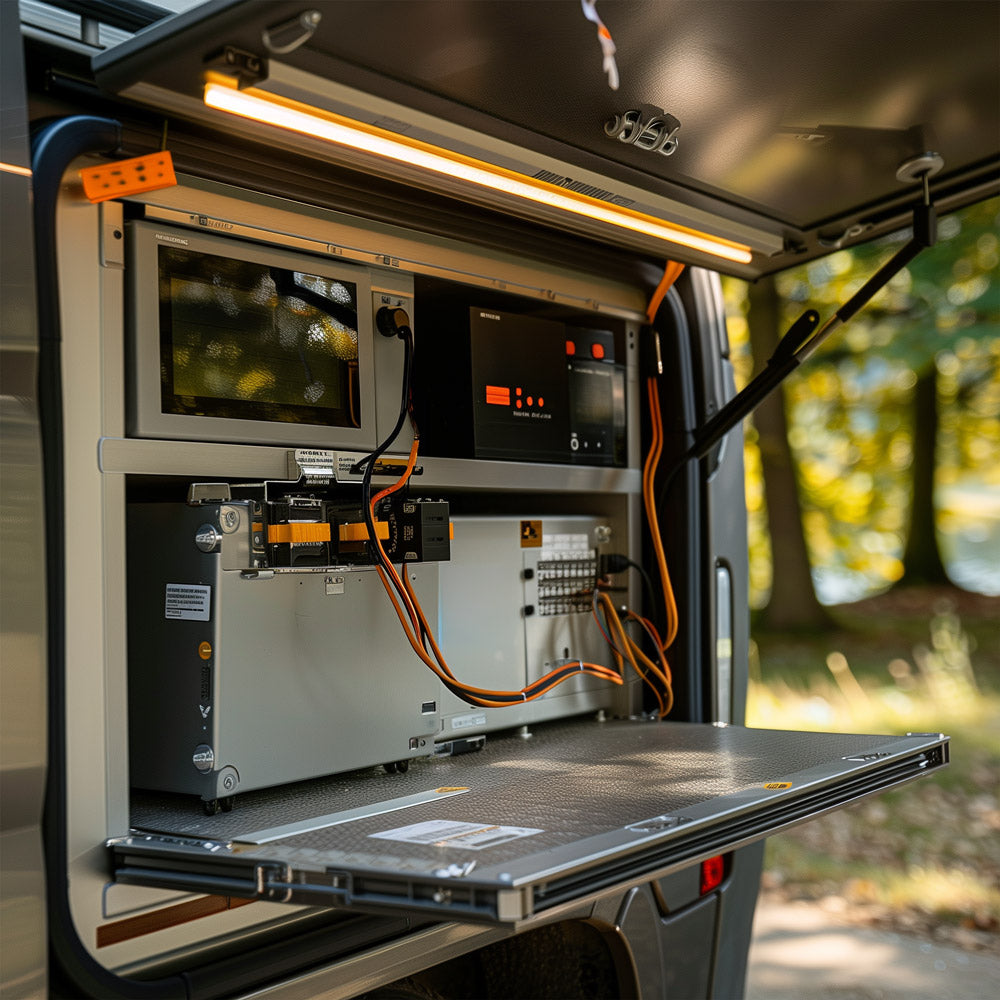
Welche Einstellung im Battery Management System für LiFePO4 Lithium Batterien in Automobilen?
Ein Battery Management System (BMS) für LiFePO4 Lithium Batterien in Ihrem Fahrzeug erfordert präzise Einstellungen zur Batterieüberwachung. Wichtige Parameter sind Spannungswächter, Spannungsmesser, und Batteriesensor. Die Nutzung von Batteriecomputer, WiFi Battery Monitor, und Batteriemessgerät gewährleistet Echtzeitdaten. Batteriewächter, Batterie Tester, Batterietester, und Batterietestgerät überwachen den Zustand. Lastmessung, Voltmeter, Batteriemonitor, und Batterie App unterstützen das Batteriemanagement. Im Energiemanagementsystem profitieren Flottenmanagement und Fuhrparkmanagement von dieser Entwicklung.
Welche Einstellung im Battery Management System für LiFePO4 Lithium Batterien in Automobilen?
Ein Battery Management System (BMS) für LiFePO4 Lithium Batterien in Ihrem Fahrzeug erfordert präzise Einstellungen zur Batterieüberwachung. Wichtige Parameter sind Spannungswächter, Spannungsmesser, und Batteriesensor. Die Nutzung von Batteriecomputer, WiFi Battery Monitor, und Batteriemessgerät gewährleistet Echtzeitdaten. Batteriewächter, Batterie Tester, Batterietester, und Batterietestgerät überwachen den Zustand. Lastmessung, Voltmeter, Batteriemonitor, und Batterie App unterstützen das Batteriemanagement. Im Energiemanagementsystem profitieren Flottenmanagement und Fuhrparkmanagement von dieser Entwicklung.


Welches Batterie Management System ist ideal für Wohnmobile und CamperVan?
Für Wohnmobile ist ein Battery Management System (BMS) entscheidend, um die Effizienz und Langlebigkeit der Batterien zu maximieren. Ein ideales BMS umfasst mehrere wichtige Komponenten zur Batterieüberwachung. Ein Batteriewächter und Spannungswächter sorgen für die Überwachung kritischer Spannungswerte, während ein Spannungsmesser und Batteriesensor präzise Messungen durchführen.
Ein Batteriecomputer und WiFi Battery Monitor bieten Echtzeitdaten und ermöglichen eine Fernüberwachung über eine Batterie App. Batterietestgerät, Batterietester, Batteriemessgerät, und Voltmeter unterstützen die Lastmessung und geben detaillierte Einblicke in den Energiezustand und die Leistung von Batteriemanagementsystemen.
Ein Batteriemonitor und ein umfassendes Batteriemanagement sorgen für die effiziente Regulierung der Lade- und Entladezyklen. Ein integriertes Energiemanagementsystem kann auch von Flottenmanagement und Fuhrparkmanagement profitieren, da es eine optimale Nutzung des Energiequellen Batteriemanagementsystems gewährleistet.
Zusammengefasst bietet ein BMS mit diesen Funktionen nicht nur eine zuverlässige Batterieüberwachung, sondern auch eine verbesserte Leistungsabgabe und Langlebigkeit der Batterien, was für Wohnmobile besonders wichtig ist.
Welches Batterie Management System ist ideal für Wohnmobile und CamperVan?
Für Wohnmobile ist ein Battery Management System (BMS) entscheidend, um die Effizienz und Langlebigkeit der Batterien zu maximieren. Ein ideales BMS umfasst mehrere wichtige Komponenten zur Batterieüberwachung. Ein Batteriewächter und Spannungswächter sorgen für die Überwachung kritischer Spannungswerte, während ein Spannungsmesser und Batteriesensor präzise Messungen durchführen.
Ein Batteriecomputer und WiFi Battery Monitor bieten Echtzeitdaten und ermöglichen eine Fernüberwachung über eine Batterie App. Batterietestgerät, Batterietester, Batteriemessgerät, und Voltmeter unterstützen die Lastmessung und geben detaillierte Einblicke in den Energiezustand und die Leistung von Batteriemanagementsystemen.
Ein Batteriemonitor und ein umfassendes Batteriemanagement sorgen für die effiziente Regulierung der Lade- und Entladezyklen. Ein integriertes Energiemanagementsystem kann auch von Flottenmanagement und Fuhrparkmanagement profitieren, da es eine optimale Nutzung des Energiequellen Batteriemanagementsystems gewährleistet.
Zusammengefasst bietet ein BMS mit diesen Funktionen nicht nur eine zuverlässige Batterieüberwachung, sondern auch eine verbesserte Leistungsabgabe und Langlebigkeit der Batterien, was für Wohnmobile besonders wichtig ist.

Fragen & Antworten
Welche Batterie Management Systeme mit WiFi Battery Monitor?
Batterie-Management-Systeme (BMS) mit einem WiFi Battery Monitor bieten zahlreiche Vorteile für die Überwachung und Verwaltung von Batteriesystemen. Diese Systeme ermöglichen die Batterieüberwachung in Echtzeit, wodurch Benutzer den Energiezustand, die Spannung und andere wichtige Parameter der Batterie aus der Ferne überwachen können. Ein typisches BMS mit WiFi-Monitor umfasst Batteriewächter, Spannungswächter und Batteriesensoren, die zusammenarbeiten, um die Batterie vor Überladung, Tiefentladung und anderen potenziellen Schäden zu schützen. Die Integration eines Batteriecomputers oder Batterietestgeräts sorgt für eine präzise Messung und Überwachung. Diese Systemnetzwerke sind ideal für Anwendungen in Wohnmobilen, Booten und Solaranlagen, wo die Fähigkeit zur Fernüberwachung von Batteriemanagementsystemen entscheidend ist.
Welche Batterie Management Systeme für die mobile Anwendung?
Für mobile Anwendungen sind flexible und zuverlässige BMS unerlässlich. Solche Systemnetzwerke bieten umfassende Batterieüberwachung und ermöglichen den optimalen Betrieb unter verschiedensten Bedingungen. Ein Batteriewächter und Spannungswächter sorgen dafür, dass die Batterien vor Überladung und Tiefentladung geschützt sind. Moderne mobile BMS umfassen oft Batteriesensoren und Spannungsmesser, die genaue Daten über den Energiestatus und den Leistungsabgabe der Batterien liefern.
Was ist ein Batterie Management System mit Wechselrichter?
Ein Battery-Management-System (BMS) mit Wechselrichter kombiniert die Funktionen der Batterieüberwachung und Energieumwandlung, um eine effiziente Nutzung und Verwaltung von Batteriesystemen zu gewährleisten. Der Wechselrichter wandelt die von der Batterie gespeicherte Gleichspannung (DC) in Wechselspannung (AC) um, die für die meisten Haushaltsgeräte erforderlich ist. Ein solches System umfasst Komponenten wie Batteriewächter, Spannungswächter, Batteriesensoren und einen Wechselrichter. Diese arbeiten zusammen, um den Energiezustand, die Spannung, den Strom und die Leistung der Batterie zu überwachen und sicherzustellen, dass die Energie effizient genutzt wird. Durch die Integration eines Batteriecomputers und eines Batteriemessgeräts können Benutzer detaillierte Informationen über die Batterie in Echtzeit abrufen. Ein Batterietester und ein Voltmeter helfen, die Batterie vor Überladung, Tiefentladung und anderen potenziellen Schäden zu schützen.
Noch mehr Wissen
Welches Batterie-Management-System für Boot und Yacht?
Für Boote und Yachten ist ein zuverlässiges BMS unerlässlich, um die Batterien optimal zu überwachen und zu verwalten. Ein ideales BMS sollte umfassende Batterieüberwachung bieten und mehrere Komponenten integrieren. Ein Batteriewächter und Spannungswächter sorgen dafür, dass die Batterien nicht über- oder unterladen werden. Spannungsmesser und Batteriesensoren liefern präzise Daten zur Spannung und zum Zustand der Batterien.
Ein Batteriecomputer und ein WiFi Battery Monitor ermöglichen die Echtzeitüberwachung und -steuerung über eine Batterie App. Mit Batterietestgerät, Batterietester, Batteriemessgerät und Voltmeter können Sie detaillierte Lastmessungen durchführen und den Energiezustand der Batterien überprüfen.
Ein Batteriemonitor und ein umfassendes Batteriemanagement gewährleisten die effiziente Regulierung der Strom Lade- und Entladezyklen, was die Lebensdauer der Batterien verlängert. Ein integriertes Energiemanagementsystem bietet zusätzliche Vorteile, besonders in der Flottenmanagement und Fuhrparkmanagement, indem es eine optimale Nutzung der Energiequellen sicherstellt.
Die Batterie Management System Funktion bietet nicht nur eine zuverlässige Batterieüberwachung, sondern auch einen verbesserten Wirkungsgrad und Langlebigkeit der Batterien, was für Boote und Yachten von entscheidender Bedeutung ist.
Welches Batteriemanagementsystem ist geeignet für Solar und Photovoltaik - PV Module?
Ein geeignetes BMS für Solar- und Photovoltaikanlagen sollte speziell auf die Anforderungen dieser Anwendungen zugeschnitten sein. Ein zuverlässiges BMS bietet umfassende Batterieüberwachung und gewährleistet den optimalen Betrieb der Solarbatterien. Batteriewächter und Spannungswächter sind essenziell, um die Batterien vor Überladung und Tiefentladung zu schützen. Ein Spannungsmesser und Batteriesensor liefern genaue Daten über den Ladezustand der Batterien.
Wie kann ein Batteriemanagementsystem (BMS) eingesetzt werden?
1. Erneuerbare Energiesysteme: In Solar- und Windenergieanlagen wird ein BMS eingesetzt, um die Speicherung und Nutzung der erzeugten Energie zu optimieren.
2. Tragbare Elektronik: Smartphones, Laptops und andere tragbare Geräte verwenden BMS, um die Akkuleistung und -sicherheit zu gewährleisten.
3. Industrielle und kommerzielle Energiespeicher: Große Batteriespeichersysteme, die in Industrie- und Gewerbeanlagen eingesetzt werden, benötigen BMS zur Überwachung und Steuerung.
4. Medizinische Geräte: Kritische medizinische Geräte, die auf Batterien angewiesen sind, verwenden BMS, um eine konstante und zuverlässige Leistung sicherzustellen.
5. Notstromsysteme und USVs (Unterbrechungsfreie Stromversorgungen): BMS werden eingesetzt, um die Batterien in diesen Systemen zu überwachen und zu steuern.
DHL Versand innerhalb Europas
Versand per DHL auch an Packstation / Postfiliale und europaweit
Kundenservice
Haben Sie Fragen? battery@hoots.de
HOOTS Empfehlen
Sie möchten HOOTS BATTERY auf Ihren Social Media Kanälen z.B. YouTube vorstellen oder vertreiben? battery@hoots.de
Sichere Bezahlmethoden
Apple Pay | Google Pay | PayPal | Klarna Rechnung | Visa | Mastercard | Vorkasse
